Venus is known as Earth’s “twin” because the two planets are so similar in size. The diameter of Venus is about 7,520 miles (12,100 kilometers). This diameter is about 400 miles (640 kilometers) smaller than that of Earth. No other planet comes nearer to Earth than does Venus. At its closest approach, it is about 23.7 million miles (38.2 million kilometers) away.
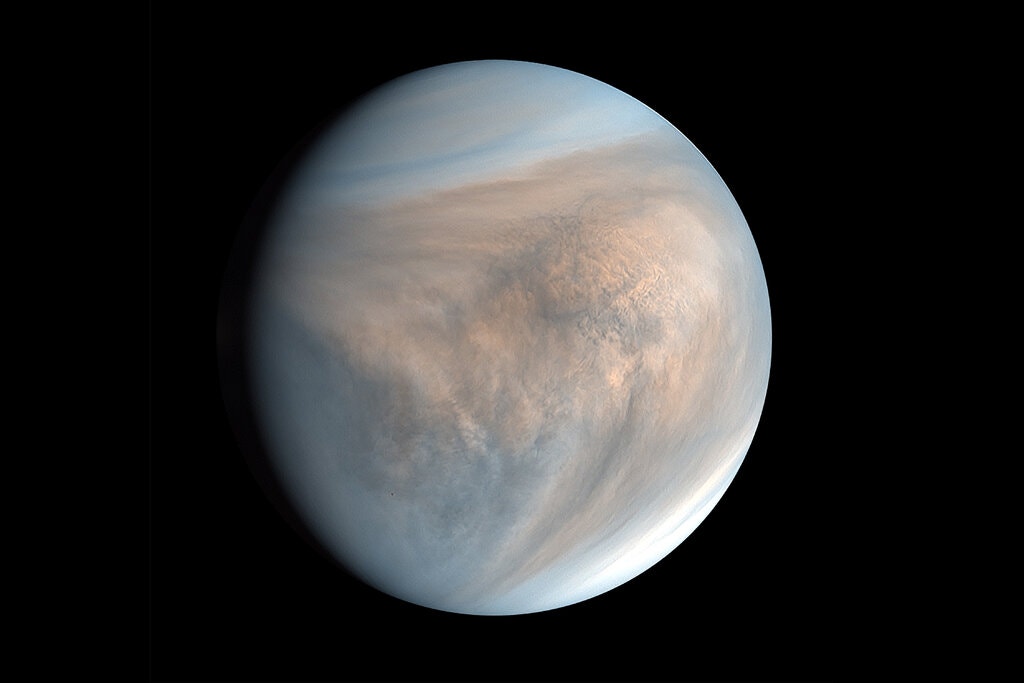
As seen from Earth, Venus appears brighter than any other planet or even any star in the night sky. At certain times of the year, Venus is the first planet or star that can be seen in the western sky in the evening. At other times, it is the last planet or star that can be seen in the eastern sky in the morning. When Venus is near its brightest point, it can be seen in daylight.
Ancient astronomers called the object that appeared in the morning Phosphorus and the one that appeared in the evening Hesperus (see Evening star). Later, they realized these objects were the same planet. They named Venus in honor of the Roman goddess of love (see Venus).
Orbit.
Venus orbits closer to the sun than does any other planet except Mercury. Venus’s average distance from the sun is about 67.2 million miles (108 million kilometers). By comparison, Earth orbits the sun at an average distance of about 93 million miles (150 million kilometers). Mercury’s average distance from the sun is about 36 million miles (57.9 million kilometers).
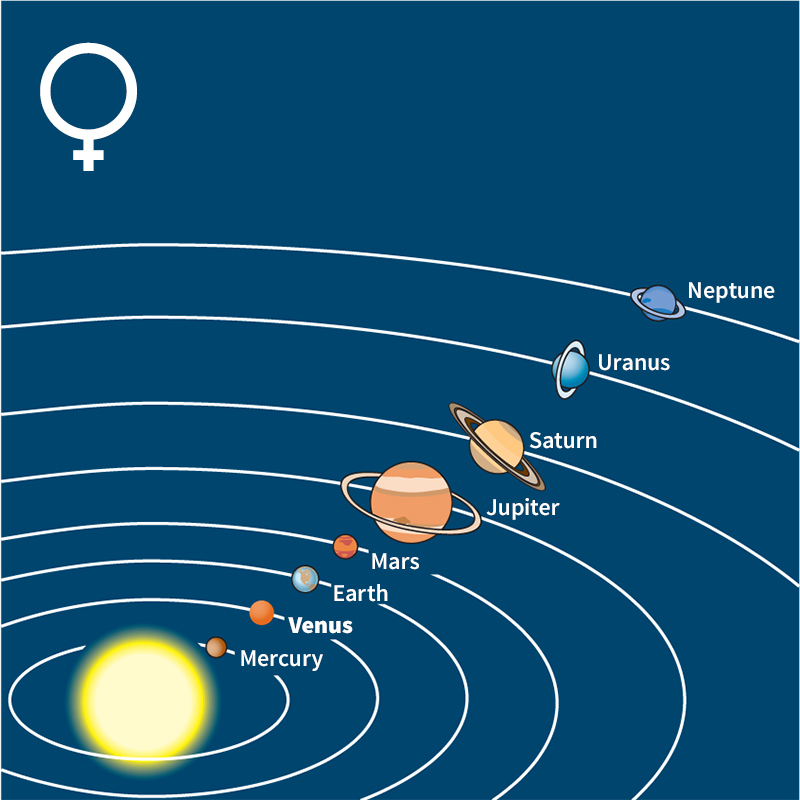
Venus travels around the sun in a nearly circular orbit. Its distance from the sun varies from 67.7 million miles (109 million kilometers) at its farthest point to about 66.8 million miles (107.5 million kilometers) at its closest point. The orbits of all the other planets are more elliptical (oval-shaped). Venus takes about 225 Earth days, or about 7 1/2 months, to go around the sun once.
Phases.
Seen through a telescope, Venus can appear to undergo changes in shape and size. These apparent changes are called phases. They resemble the phases of the moon. They result from different parts of Venus’s sunlit side being visible from Earth at different times. 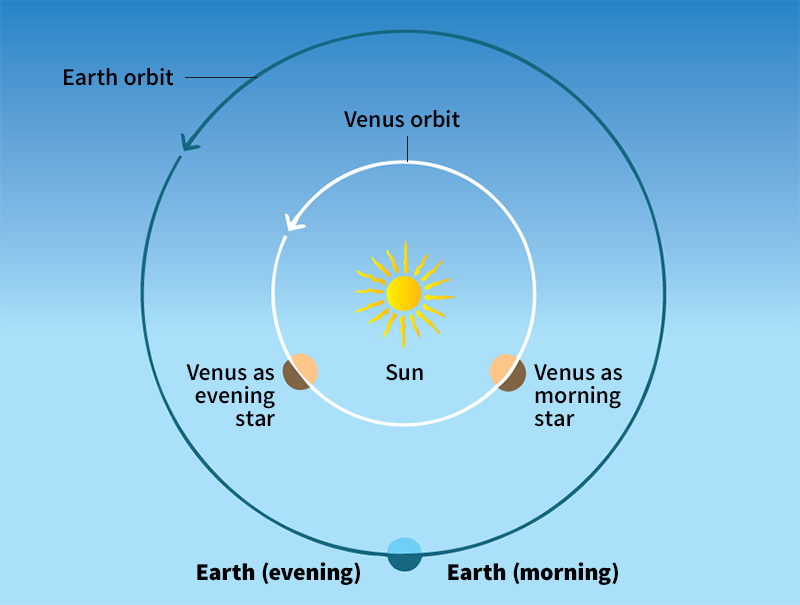
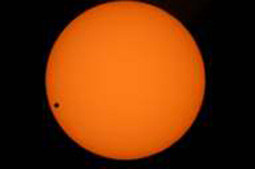
Because Venus and Earth orbit at different rates, their position in relation to the sun changes. Venus reaches the opposite side of the sun from Earth about every 584 days. Around this point, almost all of Venus’s sunlit area is visible. The planet appears as a round disk. As Venus continues toward Earth, it appears to grow larger. But its sunlit area appears to decrease. After about 221 days, only half the planet is visible. After another 71 days, Venus nears the same side of the sun as Earth. Only a thin crescent of sunlit area can be seen.
When moving toward Earth, Venus can be seen in the early evening. Venus appears in the early morning when moving away from Earth.
Rotation.
As Venus travels around the sun, it rotates slowly on its axis. The axis is an imaginary line through the planet’s center. This rotation is retrograde (in the opposite direction) to the planet’s orbit.
Venus rotates completely relative to the stars once every 243 Earth days. But because of the planet’s orbit and retrograde rotation, the time between one sunrise and the next on Venus is only about 117 Earth days.
Venus’s axis is tilted only 2 degrees from perpendicular relative to its orbit. Earth’s tilt, by contrast, is 23 1/2 degrees. As a result of the lack of tilt, the sun remains almost directly over Venus’s equator. The sun’s position minimizes seasonal changes in solar heating.
Surface and atmosphere.
Although Venus is called Earth’s “twin,” its surface conditions differ from those of Earth. Thick clouds of sulfuric acid surround the planet. The clouds make it difficult to learn about the surface. To “explore” Venus, scientists have relied on radar, radio astronomy equipment, and space probes (unpiloted devices sent to explore space).
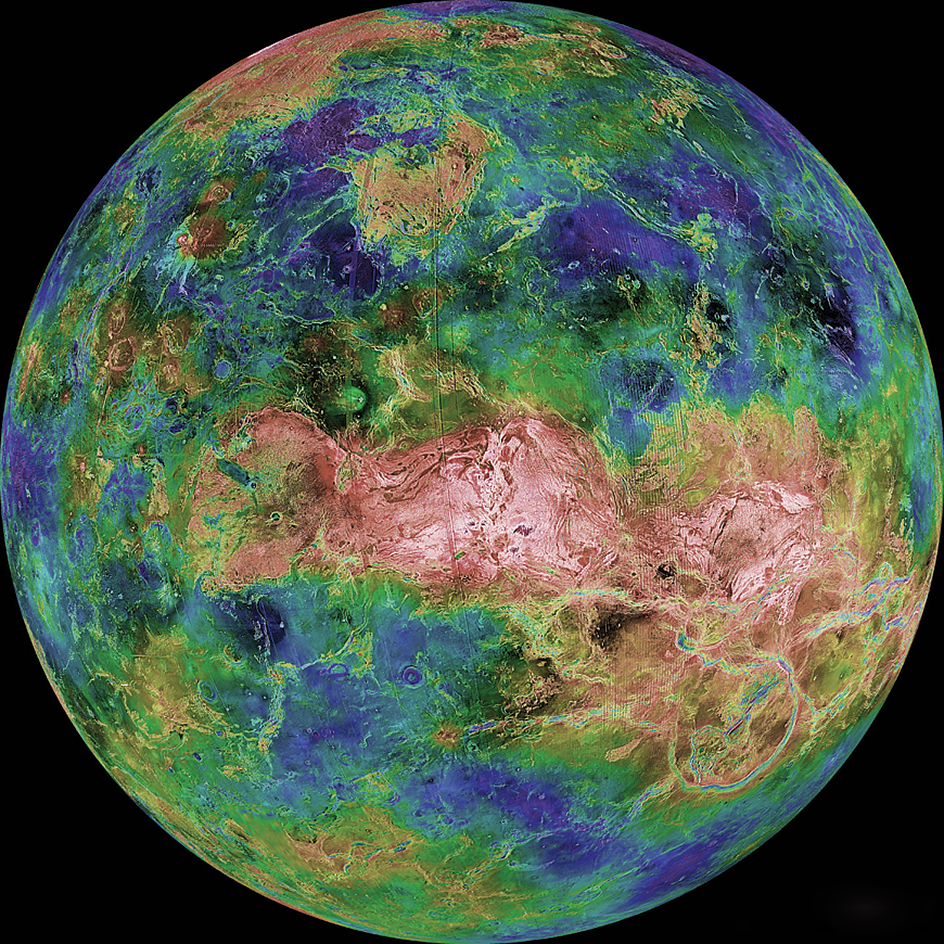
Venus’s surface appears hot and dry. There is no liquid water because the heat would cause it to boil away. Some researchers think that several billion years ago, Venus may have had an ocean. It may also have had a climate more like that of Earth.
Venus has a variety of surface features. They include plains, mountains, canyons, and valleys. Flat, smooth plains cover about 65 percent of the surface. Thousands of volcanoes dot these plains. The volcanoes range from about 0.5 to 150 miles (0.8 to 240 kilometers) in diameter. Six mountainous regions make up about 35 percent of the surface of Venus. One mountain range, called Maxwell, rises about 7 miles (11 kilometers) high. It stretches about 540 miles (870 kilometers) long. It is the highest feature on the planet. In an area called Beta Regio is a canyon that is 0.6 mile (1.0 kilometer) deep.
There are also impact craters on the surface of Venus. Impact craters form when an asteroid or other small body strikes a planet. Venus has fewer craters than do the moon, Mars, and Mercury. This fact suggests that Venus’s present surface is less than 1 billion years old. It also suggests, along with other evidence, that Venus remains volcanically active.
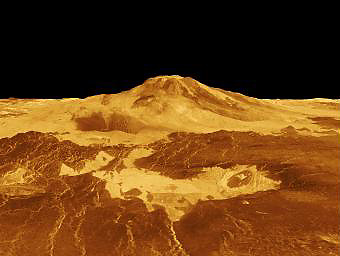
Many surface features on Venus are unlike anything on Earth. For example, Venus has coronae (crowns). These ringlike structures range from about 95 to 360 miles (150 to 580 kilometers) in diameter. Scientists think that coronae form when hot material inside the planet rises to the surface. Venus also has tesserae (tiles). The tesserae are raised areas in which many ridges and valleys have formed in different directions.
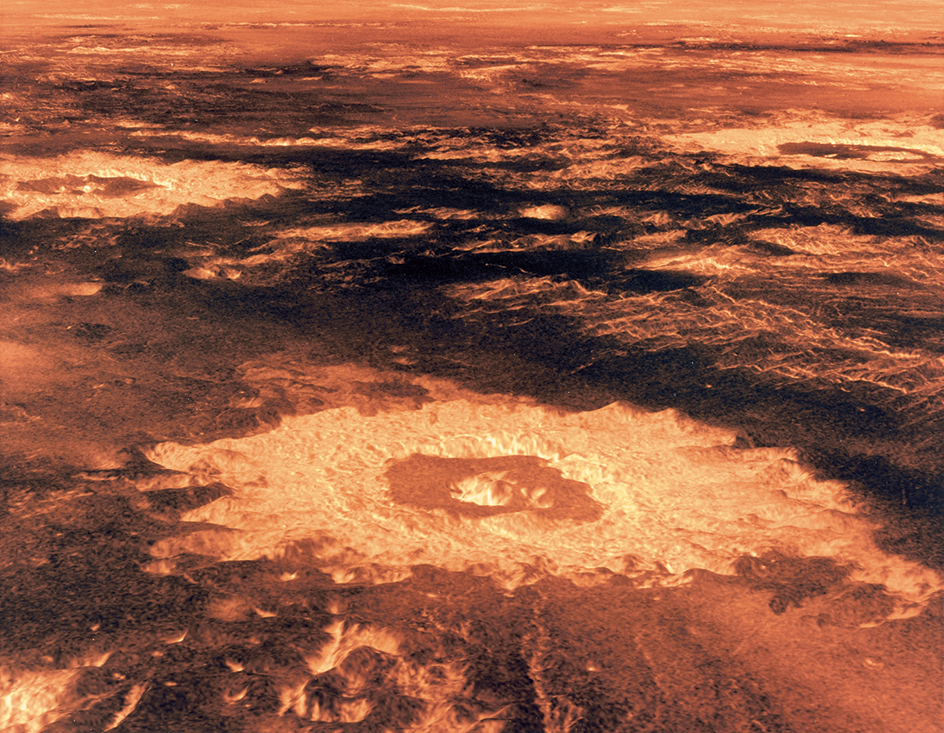
The atmosphere of Venus is heavier than that of any other planet. It consists primarily of carbon dioxide. It has small amounts of nitrogen and water vapor. The planet’s atmosphere also contains minute traces of argon, carbon monoxide, neon, and sulfur dioxide. The atmospheric pressure (pressure exerted by the weight of the gases) on Venus is estimated at 1,323 pounds per square inch (9,122 kilopascals). This pressure is about 90 times greater than the atmospheric pressure on Earth.
Venus’s atmosphere is dry, with only small amounts of water vapor. Scientists think Venus must have once had more water. They are not certain where all the water went.
A number of space probes have provided information about Venus. Landing probes on Venus is a major challenge for engineers. Such craft must withstand high temperatures, corrosive gases, and high surface pressures.

Temperature.
Venus’s uppermost cloud layer has an average temperature of about 55 °F (13 °C). However, the temperature of the planet’s surface is about 870 °F (465 °C). That temperature is hotter than that of any other planet.
The plants and animals that live on Earth could not live on the surface of Venus, because of the heat. Astronomers doubt that any form of life exists on Venus. But some scientists have suggested that microbes could survive in the cloud tops.
Most astronomers think that Venus’s high surface temperature can be explained by what is known as the greenhouse effect. A greenhouse lets in radiant energy from the sun. But it prevents much of the heat from escaping. The thick clouds and dense atmosphere of Venus work in much the same way. The sun’s radiant energy filters into the planet’s atmosphere. But the large droplets of sulfuric acid in Venus’s clouds, and the great quantity of carbon dioxide in the atmosphere, trap much of the solar energy at the surface.
Mass and density.
The mass (amount of matter) of Venus is about four-fifths that of Earth. The force of gravity on Venus is less than on Earth. For this reason, an object weighing 100 pounds (45 kilograms) on Earth would weigh about 91 pounds on Venus (the equivalent of about 41 kilograms on Earth). Venus is also less dense than Earth.
Flights to Venus.
Venus was the first planet to be observed by a passing spacecraft. The National Aeronautics and Space Administration (NASA) spacecraft Mariner 2 passed within 21,600 miles (34,800 kilometers) of Venus in 1962. Mariner measured various conditions on and near Venus. Two Soviet spacecraft explored Venus in 1966. Venera 2 passed within 15,000 miles (24,000 kilometers) of the planet. Venera 3 crashed into Venus.
In 1967, spacecraft from both the United States and the Soviet Union reached Venus. The Soviet spacecraft Venera 4 dropped a capsule of instruments into Venus’s atmosphere by parachute. The NASA spacecraft Mariner 5 passed within 2,480 miles (3,990 kilometers) of Venus. It did not detect a planetary magnetic field (area of magnetic influence surrounding a planet). Both probes reported large amounts of carbon dioxide in the planet’s atmosphere. In 1970, the Soviet spacecraft Venera 7 landed on Venus. The NASA planetary probe Mariner 10 flew near Venus in 1974. The probe transmitted the first close-up photographs of the planet.
In 1975, the Soviet probe Venera 9 landed on Venus. It provided the first close-up photograph of the planet’s surface. That same year, another Soviet space probe, Venera 10, entered Venus’s atmosphere. It photographed Venus’s surface. It also measured atmospheric pressure and studied the composition of surface rocks. The two spacecraft that carried these probes remained in orbit, becoming the first craft to orbit Venus.
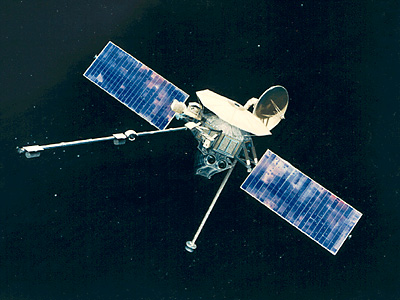
Four spacecraft reached Venus in 1978. NASA’s Pioneer Venus 1 orbited the planet. It transmitted radar images of Venus. It also produced a map of the surface and measured temperatures at the cloud tops. The craft continued to circle Venus for 14 years. It gathered data until it fell into the atmosphere and burned up in 1992. Also in 1978, NASA’s Pioneer Venus 2 probe entered the planet’s atmosphere. It released three small probes. These craft measured the composition and structure of the atmosphere at four different locations as they fell to the surface. The Soviet probes Venera 11 and Venera 12 landed on Venus. Both probes studied the lower atmosphere and surface.
Two more Soviet spacecraft landed on Venus in 1982—Venera 13 and Venera 14. Both probes transmitted photographs of Venus and analyzed soil samples. Beginning in 1983, two additional Soviet spacecraft mapped the region of Venus north of 30° north latitude using radar. Venera 15 and Venera 16 finished their mapping in 1984. The two probes provided images of features as small as 0.9 mile (1.5 kilometers) across.
The NASA spacecraft Magellan began orbiting Venus in 1990. Its radar images showed surface details as small as 330 feet (100 meters) across. In 1994, controllers lowered Magellan’s altitude. This move enabled the craft to take measurements inside the atmosphere before crashing into Venus.
The European Space Agency’s Venus Express probe went into orbit around the planet in 2006. Its cameras sent back views of Venus’s southern hemisphere. The images enabled scientists to determine that wind speeds on Venus reach about 230 miles per hour (370 kilometers per hour). The craft also observed a circular storm centered at the south pole. The storm appeared similar to a cyclone on Earth. The craft used devices called spectrometers to measure the composition of the atmosphere.
Data from Venus Express have shown that atoms of hydrogen and oxygen are escaping from Venus into space in a 2-to-1 proportion. This ratio is the same found in water molecules. It supports earlier evidence that Venus once had more water vapor in its atmosphere. Venus Express also found evidence of lightning in the planet’s clouds. In addition, it detected infrared light coming from the night sky of the planet. This light, called nightglow, is thought to come from chemical reactions in the upper atmosphere. The Venus Express mission ended in 2014.
In 2010, the Japan Aerospace Exploration Agency (JAXA) launched the probe Akatsuki towards Venus. Although Akatsuki arrived at the planet later that year, it failed to enter into orbit and drifted around the sun for five years. In 2015, during the craft’s next approach with Venus, JAXA engineers managed to put the craft into orbit. Akatsuki began studying Venus’s dense atmosphere in greater detail than had been possible before.
Scientists have also studied Venus using NASA’s Parker Solar Probe, launched in 2018. The probe uses flybys of the planet to alter its orbit to more closely approach its main mission target, the sun. During these flybys, scientists have used the probe’s cameras to photograph Venus’s clouds and surface.
